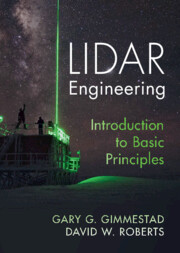Book contents
- Lidar Engineering
- Lidar Engineering
- Copyright page
- Dedication
- Contents
- Preface
- Glossary
- List of Abbreviations
- 1 Introduction
- 2 The Basic Lidar Models
- 3 The Molecular Atmosphere
- 4 Particles in the Atmosphere
- 5 Lidar Transmitters
- 6 Lidar Receivers and the Geometrical Function
- 7 Optomechanics
- 8 Optical Detection
- 9 Data Systems
- 10 Lidar Data Analysis
- 11 Applications
- Appendix A The Klett Retrieval
- Index
- References
9 - Data Systems
Published online by Cambridge University Press: 16 February 2023
- Lidar Engineering
- Lidar Engineering
- Copyright page
- Dedication
- Contents
- Preface
- Glossary
- List of Abbreviations
- 1 Introduction
- 2 The Basic Lidar Models
- 3 The Molecular Atmosphere
- 4 Particles in the Atmosphere
- 5 Lidar Transmitters
- 6 Lidar Receivers and the Geometrical Function
- 7 Optomechanics
- 8 Optical Detection
- 9 Data Systems
- 10 Lidar Data Analysis
- 11 Applications
- Appendix A The Klett Retrieval
- Index
- References
Summary
Analog data systems use fast digitizers to convert continuous voltage waveforms into digital signals with discrete values in both time and voltage. The voltage resolution is limited by the digitizer’s number of bits, so the output is in discrete steps, which causes an uncertainty called digitization noise, characterized by the ideal SNR for a given number of bits. The SNR improvement caused by averaging is quantified. Static figures of merit include offset and gain errors and nonlinearities. Dynamic figures of merit include signal-to-noise and distortion ratio, total harmonic distortion, effective number of bits, and spurious free dynamic range, all measured by a fast Fourier transform, and aperture error. Testing methods include the histogram test, which is illustrated with an example. A testing summary table is provided. Photon counting data systems have a discriminator, a shaper, and a counter. The shaper has a dead time between pulses that causes a maximum count rate. Models of the true versus measured count rates are given for both paralyzable and non-paralyzable photon counting systems. Hybrid analog/photon counting data systems are described.
Keywords
- Type
- Chapter
- Information
- Lidar EngineeringIntroduction to Basic Principles, pp. 246 - 267Publisher: Cambridge University PressPrint publication year: 2023



